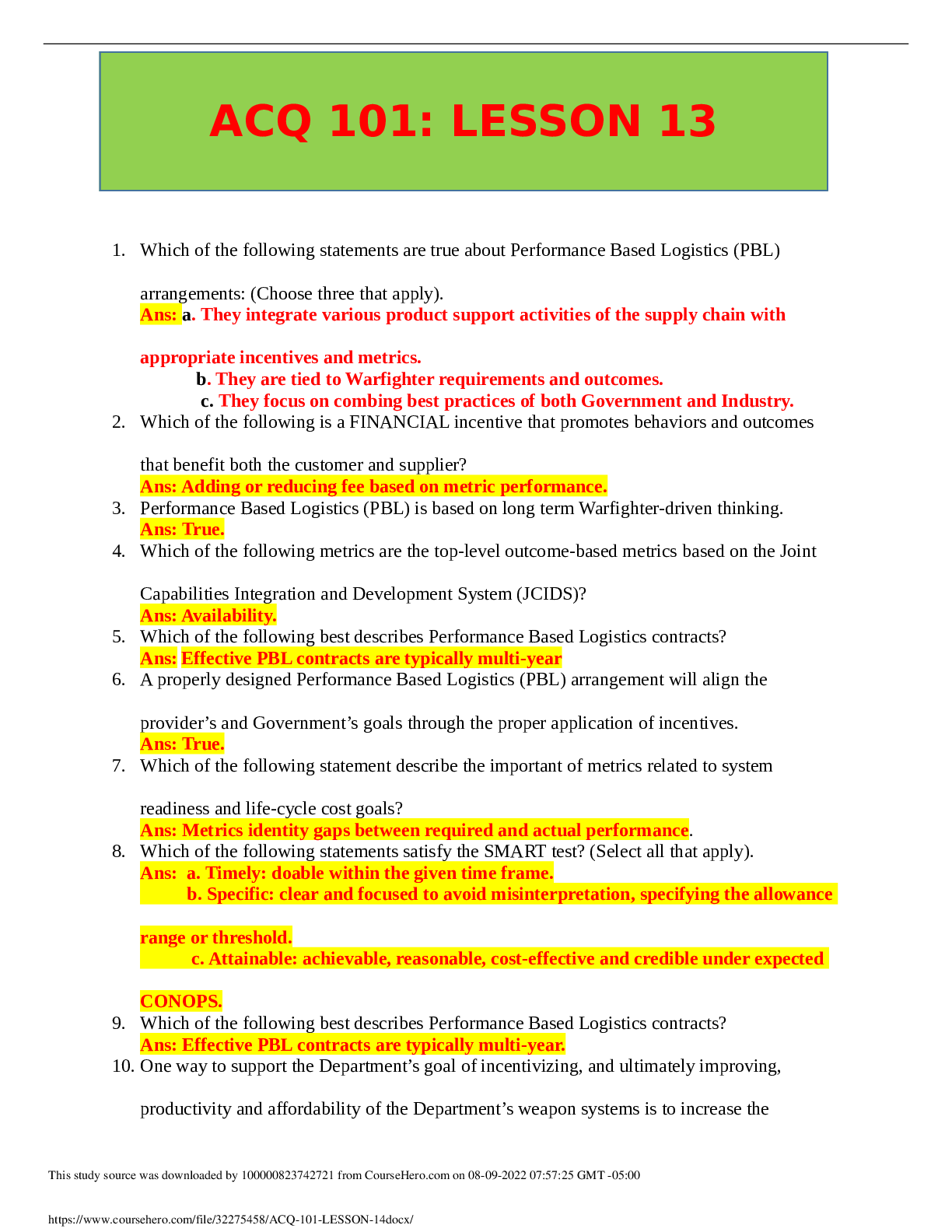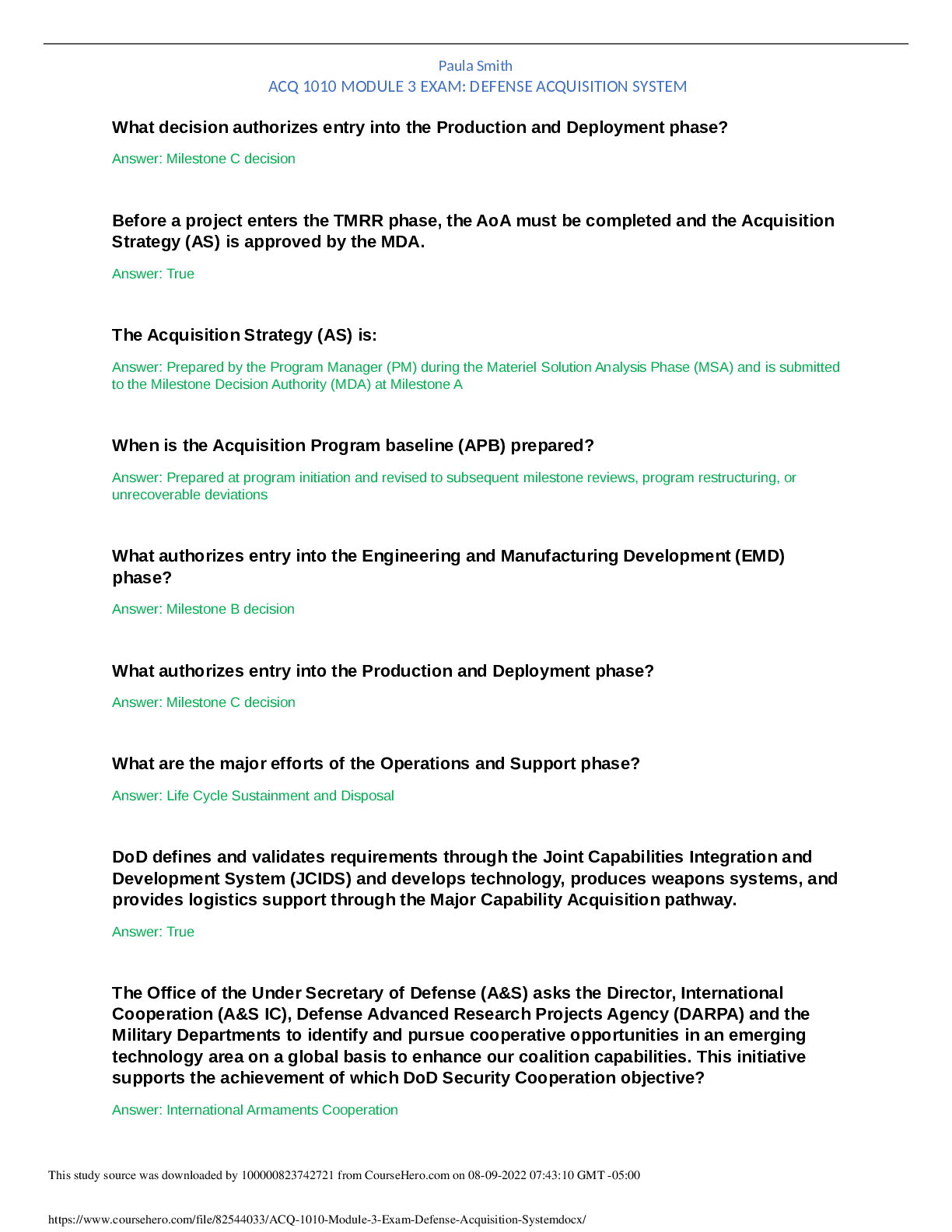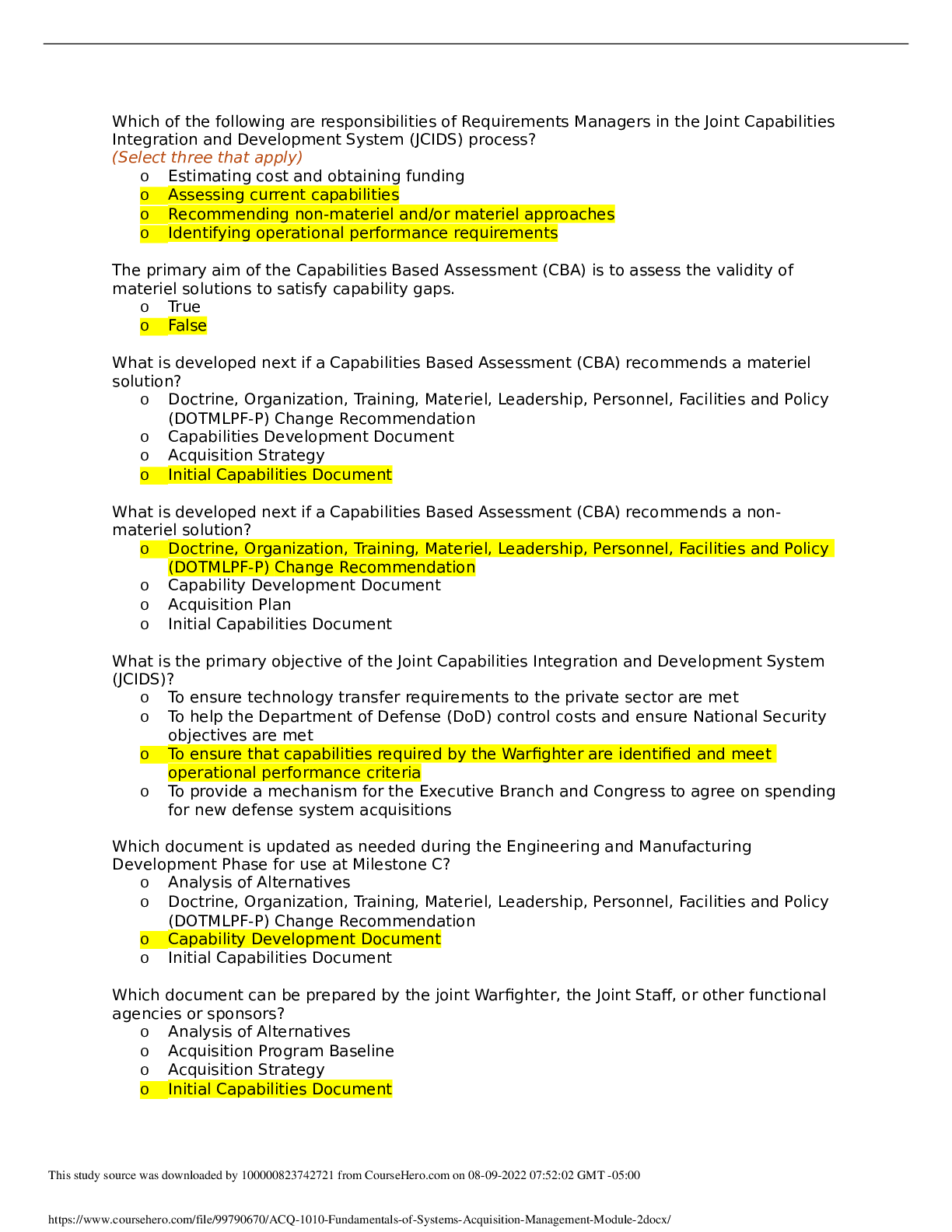*NURSING > QUESTIONS & ANSWERS > Davis Edge- Musculoskeletal Disorders Week 5 (All)
Davis Edge- Musculoskeletal Disorders Week 5
Document Content and Description Below
Davis Edge- Musculoskeletal Disorders Week 5 Mr. McKinsey, age 69, was recently given a diagnosis of degeneratve joint disease. Which assessment should the nurse practtoner use to check for effusio... n of the patent’s knee? a. Thomas test b. Tinel Test c. Bulge test d. Phalen test A nurse practtoner is driving home from work and stops at the scene of a motorcycle accident that must have just occurred, as there are no rescue vehicles present. The driver is lying unconscious at the side of the road with an obvious open fracture of his femur. Which of the following actons should take priority? a. Stopping the bleeding from the wound. b. Determining if there has been a cervical fracture. c. Establishing an airway. d. Palpatng the peripheral pulses. The valgus stress test, varus stress test, Lachman test, and thumb sign are all considered standard tests to check the integrity of the ligaments of the knee. Which test would the nurse practtoner choose to assess the anterior cruciate ligament (ACL), which is the most commonly involved structure in severe knee injury? a. Valgus stress test. b. Varus stress test. c. Lachman test. d. Thumb sign. You are assessing Jamal, age 16, afer a football injury to his right knee. You elicit a positve anterior/posterior drawer sign. This test indicates an injury to the: a. Lateral meniscus. b. Cruciate ligament. c. Medial meniscus. d. Collateral ligament. Cass, age 67, tells the nurse practtoner (NP) that she has been diagnosed with a conditon that causes sudden flares of pain, swelling, and redness of the joints in her toes. She cannot remember the name of the diagnosis, but she knows it is caused by urate crystals that “get stuck in the joint and cause pain.” She is on hydrochlorothiazide (HCTZ) for management of her hypertension. The NP should suspect a diagnosis of: A. Septc arthrits. B. Gout.C. Rheumatoid arthrits. D. Charcot neuro-osteoarthropathy. Ethan, age 10, jumped off a 2-foot wall, twistng his foot and ankle upon landing. His ankle x-ray demonstrates a fracture of the distal tbia, over the artcular surface, through the epiphysis and physis. Based on the Salter-Harris classifcaton of growth plate injuries, you know this is a: a. Salter-Harris II fracture. b. Salter-Harris III fracture. c. Salter-Harris IV fracture. d. Salter-Harris V fracture. Mrs. Kelly, age 80, has a curvature of the spine. This is likely to indicate which age-related change? a. Lordosis. b. Dorsal kyphosis. c. Scoliosis. d. Kyphoscoliosis. Upon assessment, the nurse practtoner notes unilateral back pain of acute onset that increases when standing and bending. A straight leg raise test is negatve. The most likely diagnosis is: a. Herniated nucleus pulposus. b. Muscle strain. c. Osteoarthrits. d. Spondylolisthesis. Joyce, age 87, broke her wrist afer falling off a curb. She just had a plaster cast applied to her wrist. In instructng Joyce and her family on allowing the cast to dry properly, tell them to: a. Contnuously elevate Joyce’s arm on a pillow. b. Change the positon of Joyce’s arm every hour. c. Positon a fan near Joyce during the night to ensure even drying of the cast. d. Put a blanket over the cast to absorb the dampness. Anne, age 67, sustained a fall on an outstretched hand. She presents holding her arm against her chest with her elbow flexed. Based on the specifc locaton of her pain, you suspect a radial head fracture. The best inital strategy to assess for a radial head fracture would be: a. To palpate for tenderness, swelling, and crepitus just distal to the lateral epicondyle. b. To palpate for tenderness, swelling, and crepitus along the radial wrist. c. To palpate for tenderness in the “anatomical snufox.”d. To order an x-ray of the wrist. Lillian, age 70, was told that she has osteoporosis. When she asks you what this is, you respond that osteoporosis: a. Develops when loss of bone occurs more rapidly than new bone growth. b. Is a degeneratve joint disease characterized by loss of cartlage in certain joints. c. Is a chronic inflammatory disorder that affects multple joints. d. Is a bone disorder that has to do with inadequate mineralizaton of the bones. Jeffrey, age 16, was involved in a motor vehicle accident. He walks in to the ofce with an obvious facial fracture and then collapses. What should the frst acton of the nurse practtoner be? a. Calling his parents for permission to treat. b. Assessing for an adequate airway. c. Obtaining a head and maxillofacial computed tomography (CT). d. Assessing for a septal hematoma. Marsha, age 34, presents with symptoms resembling both fbromyalgia and chronic fatgue syndrome, which have many similarites. Which of the following is more characteristc of fbromyalgia than of chronic fatgue syndrome? a. Musculoskeletal pain. b. Difculty sleeping. c. Depression. d. Fatgue. The nurse practtoner (NP) is assessing Maya, a 69-year-old Asian woman, for the frst tme. When trying to differentate between scoliosis and kyphosis, the NP recalls that kyphosis involves: a. Asymmetry of the shoulders, scapulae, and waist creases. b. A lateral curvature and vertebral rotaton on posteroanterior x-rays. c. One leg appearing shorter than the other. d. A posterior rounding at the thoracic level. Alexander, age 12, sprained his ankle playing ice hockey. He is confused as to whether he should apply heat or cold. What should the nurse practtoner tell him? a. “Use contnuous heat for the frst 12 hours and then use heat or cold to your own preference.” b. “Use contnuous cold for the frst 12 hours and then use heat or cold to your own preference.”c. “Apply cold for 20 minutes, then remove it for 30 to 45 minutes; repeat this for the frst 24 to 48 hours while awake.” d. “Alternate between cold and heat for 20 minutes each for the frst 24 to 48 hours.” The nurse practtoner (NP) suspects a herniated disk in a 72-year-old patent. The NP elevates the patent’s affected leg when she is in the supine positon, and it elicits back and sciatc nerve pain, which indicates a positve test. This is known as which test or sign? a. Femoral stretch test. b. Crossed straight leg raise test. c. Doorbell sign. d. Straight leg raise test. June, age 67, presents with back pain with no precipitatng event. The pain is located over her lower back muscles and spine, without sciatca, and it is aggravated by sitng, standing, and certain movements. It is alleviated with rest. Palpaton localizes the pain, and muscle spasms are felt. There was an insidious onset with progressive improvement. What is the most likely diagnosis? a. Ankylosing spondylits. b. Musculoskeletal strain. c. Spondylolisthesis. d. Herniated disk. Hilda, age 73, presents with a complaint of low back pain. Red flags in her history of a minor fall, osteopenia, and prolonged steroid use for systemic lupus erythematosus suggest the possibility of which of the following serious underlying conditons as the cause of her low back pain? a. Cancer. b. Cauda equina syndrome. c. Neurologic compromise. d. Spinal fracture. Mickey, age 18, is on a chemotherapeutc antbiotc for a musculoskeletal neoplasm. Which drug do you think he is taking? a. Cyclophosphamide (Cytoxan). b. Doxorubicin (Adriamycin). c. Methotrexate (Rheumatrex). d. Cisplatn (Platnol). A nurse practtoner is trying to distnguish between an artcular and a nonartcular musculoskeletal complaint in a 26-year-old patent complaining of pain in the elbow area. Which of the following would characterize nonartcular bursits? a. Deep or diffuse pain.b. Limited range of moton (ROM) on actve and passive movement. c. Point or focal tenderness. d. Swelling and instability. The nurse practtoner suspects adolescent idiopathic scoliosis in Victoria, age 15, who is in her “growth spurt.” An Adams forward bend test is performed, and it is noted that the patent has a right-sided rib hump. What is this indicatve of? a. Right lumbar shifing. b. Right thoracic curvature. c. Right truncal shif. d. Spondylolysis Paul has a malignant fbrosarcoma of the femur. He recently had surgery and is now on radiaton therapy. You want to order a test to determine the extent of the tumor invasion of the surrounding tssues and the response of the bone tumor to the radiaton. Which of the following tests should you order? A. An x-ray. B. A magnetc resonance imaging (MRI) scan. C. A computed tomography (CT) scan. D. A needle biopsy. When teaching Alice, age 77, to use a cane because of osteoarthrits of her lef knee, an important point to stress is: a. Carrying the cane in the ipsilateral hand. b. Advancing the cane with the ipsilateral leg. c. Making sure the cane length equals the height of the iliac crest. d. Using the cane to aid in joint protecton and safety. Anne Marie states she has a maternal history of rheumatoid disease, but she has never been affected. Today she presents with complaints of dryness of the eyes and mouth. What is the most likely diagnosis? a. Rheumatoid arthrits (RA). b. Systemic lupus erythematosus (SLE). c. Sjögren syndrome. d. Rosacea. Greg, age 26, runs marathons and frequently complains of painful contractons of his calf muscles afer running. You atribute this to: a. Hypercalcemia. b. Hyponatremia.c. Heat exhauston. d. Dehydraton. The nurse practtoner is considering a diagnosis of calcium pyrophosphate depositon disease (CPPD), or pseudogout, in a 72-year-old man who presents with complaints of pain and stffness in his wrists and knees. The most useful diagnostc tests to assist in confrming this diagnosis would be: A. Synovial fluid analysis and x-ray. B. Bacterial cultures. C. Bone scan and magnetc resonance imaging (MRI). D. Antcitrullinated protein antbodies (ACPA) and rheumatoid factor (RF). Mathew, age 52, is a chef who just severed 2 of his fngers with a meat cuter. You would recommend that he: a. Wrap the severed fngers tghtly in a dry towel for transport to the emergency department with him. b. Leave the severed fngers at the scene because fngers cannot be reatached. c. Immediately freeze the severed fngers for reatachment in the near future. d. Wrap the fngers in a clean, damp cloth; seal them in a plastc bag; and place the bag in an ice water bath. Sean, a factory line worker, has osteoarthrits (OA) of the right hand. According to the American College of Rheumatology (ACR), the guidelines for pharmacologic treatment include: a. Acetaminophen, tramadol, and intra-artcular cortcosteroid injectons. b. Oral nonsteroidal ant-inflammatory drugs (NSAIDs), tramadol, and artcular cortcosteroid injectons. c. Acetaminophen, topical capsaicin, and topical nonsteroidal ant-inflammatory drugs (NSAIDs). d. Topical capsaicin, topical nonsteroidal ant-inflammatory drugs (NSAIDs), and oral NSAIDs. [Show More]
Last updated: 1 year ago
Preview 1 out of 12 pages
Instant download
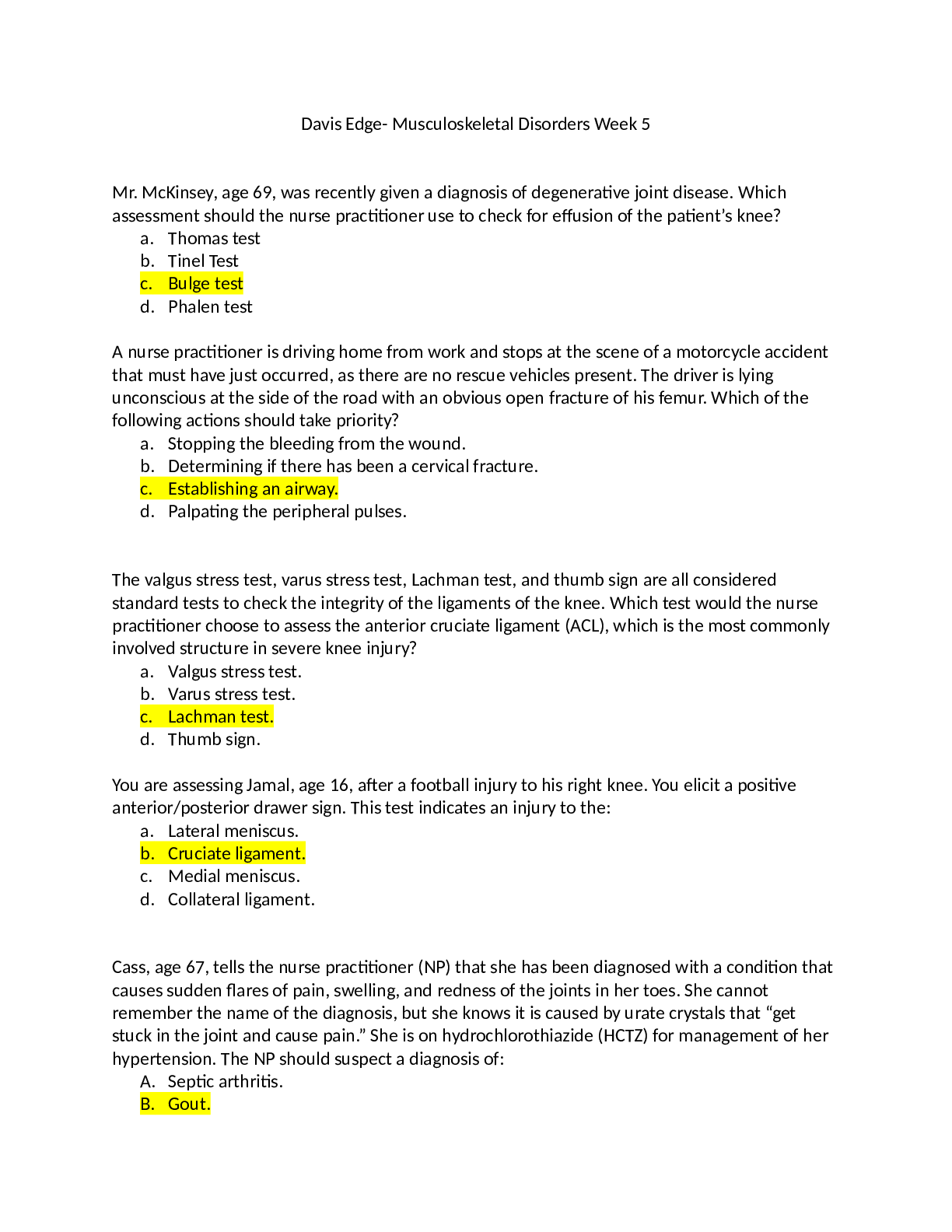
Buy this document to get the full access instantly
Instant Download Access after purchase
Add to cartInstant download
Reviews( 0 )
Document information
Connected school, study & course
About the document
Uploaded On
Jun 19, 2022
Number of pages
12
Written in
Additional information
This document has been written for:
Uploaded
Jun 19, 2022
Downloads
0
Views
100



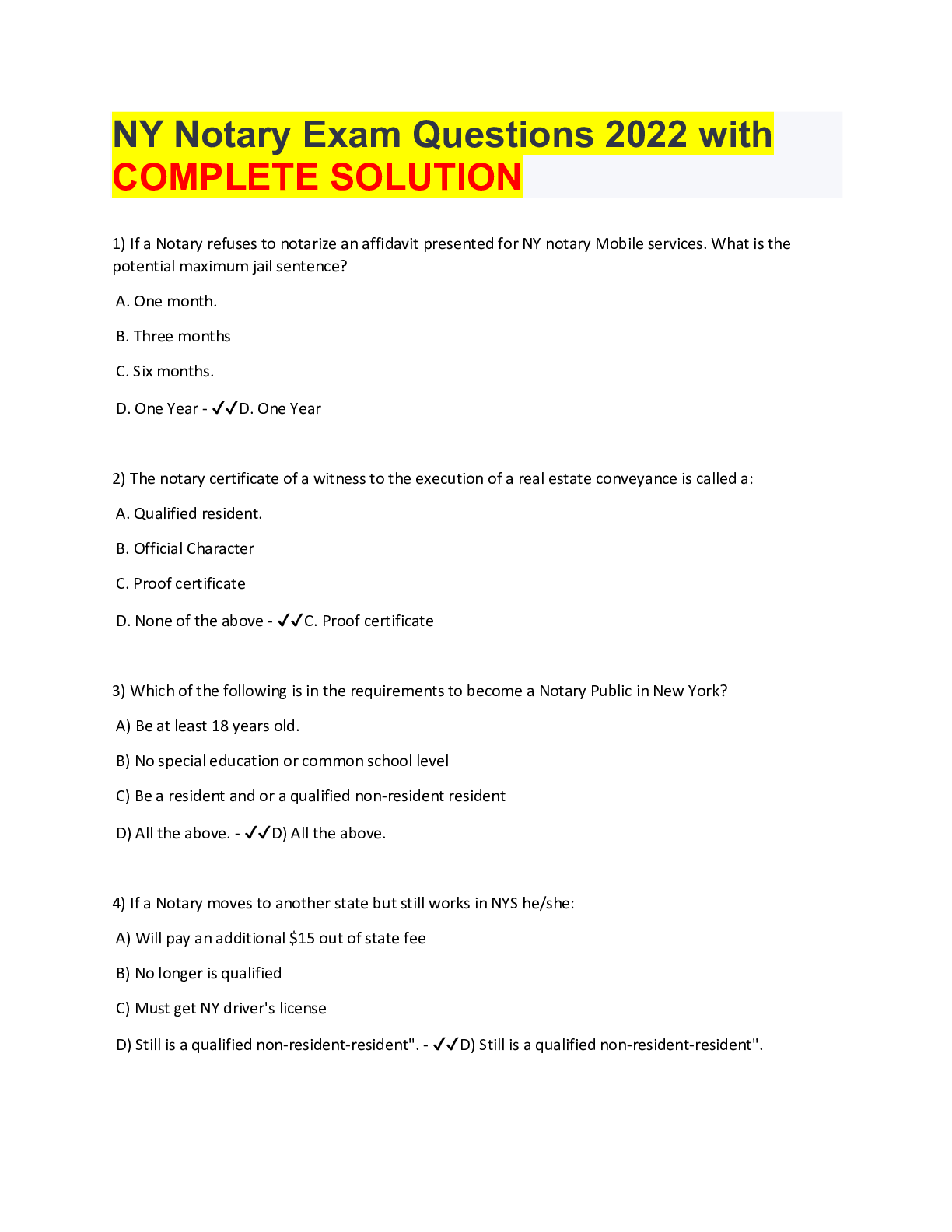


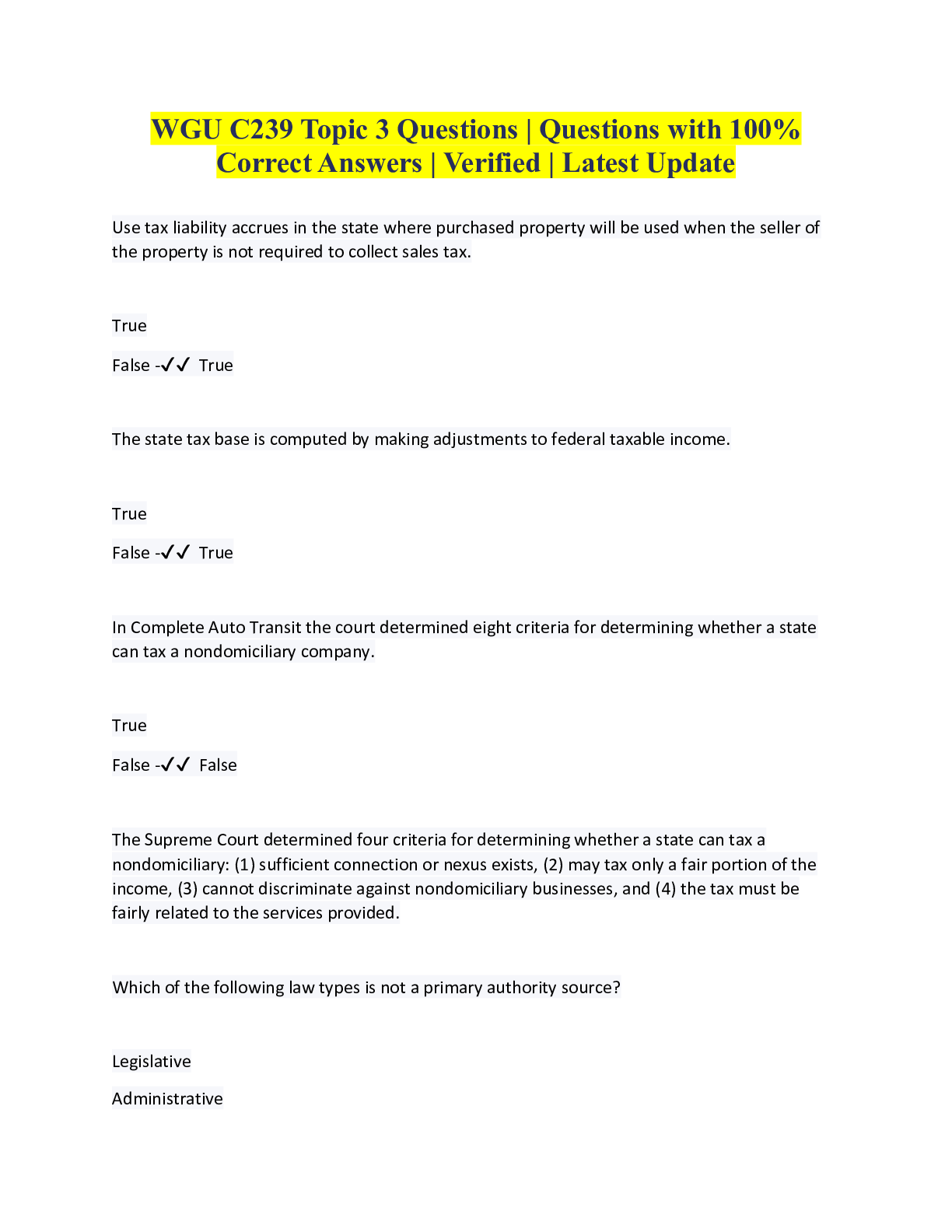
.png)


